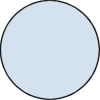Portable Network Graphics (.png)
The PNG format was released around the turn of the century. It was designed for displaying graphics on the web. It has two advantages:
- It uses lossless compression—which means you can save it over and over again without loss of quality.
- It supports the Alpha Channel.
Right! What's an Alpha Channel?
The Alpha Channel defines how transparent a color will be represented. It is another value racked on to the end of RGB, thus: RGBA. The wandering ball is an example of transparency in action. It is a shade of blue with 50% transparency.
For the geeks in the world, the color of blue in the wandering ball is #AAC4DE in RGB. However, it is 50% Transparent, so it is actually #AAC4DE80
However, you don't have to worry about the details. Your graphics program will do that. You only have to know it exists.
PNGs also handle greyscale and reduced color palettes [e.g., 256 color]. It was not designed for high-end printing so it does not support the CMYK color format. For most of us, that is not an issue.
It does have one peculiarity: Its internal resolution is in dots per centimeter, which means 300 dpi will be rounded down to 118 dpc. Is this important—not really.
For the ultimate geek, the wandering ball is done with JavaScript setting CSS properties. Cool!
